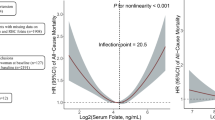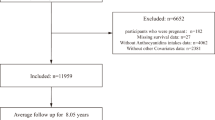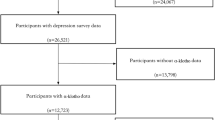Abstract
Our study aims to evaluate the associations between the serum cobalamin (vitamin B12) and related biomarkers with mortality in hypertensive adults. Data on serum cobalamin from the National Health and Nutrition Examination Survey (NHANES) 1999–2006 and 2011–2014 were included. Mortality status was linked to National Death Index mortality data through 31 December, 2019. Cox regression and restricted cubic spline (RCS) analyses were used to determine the hazard ratios (HRs) and 95% CIs for mortality risk. A total of 9934 hypertensive adults were included in the analysis (mean age, 58.1 ± 17.5 years; 4899 [49.3%] men). At 11.0 years of mean follow-up, 935 cardiovascular deaths and 3096 all-cause deaths were identified. Compared to the third quartiles, the first and fourth quartiles of serum cobalamin were associated with risk of cardiovascular mortality, with multivariable-adjusted HRs of 1.26 (1.05–1.53) and 1.40 (1.17–1.68). Similar results were observed in the relationship between serum cobalamin and all-cause mortality. These results were supported by the RCS analysis. The inflection points for the nonlinear associations of serum cobalamin with cardiovascular and all-cause mortality were 649.9 pg/mL and 577.2 pg/mL, respectively. In addition, compared with the second quartile of circulating methylmalonic acid (MMA, a cobalamin-deficiency marker), this association with the fourth quartile was evident for an increased rate of cardiovascular and all-cause mortality, with 111% (HR = 2.11, 1.71–2.61) and 73% (HR = 1.73, 1.55–1.93) increase. Findings suggest that both lower and higher serum cobalamin concentrations were associated with a higher risk of cardiovascular and all-cause mortality in hypertensive adults.

This study was a prospective cohort study that included serum cobalamin data from 9934 hypertensive adults from the NHANES from 1999–2006 and 20011–2014. Findings suggested that both lower and higher serum cobalamin concentrations were associated with a higher risk of cardiovascular and all-cause mortality in hypertensive adults.
This is a preview of subscription content, access via your institution
Access options
Subscribe to this journal
Receive 12 print issues and online access
269,00 € per year
only 22,42 € per issue
Buy this article
- Purchase on SpringerLink
- Instant access to full article PDF
Prices may be subject to local taxes which are calculated during checkout


Similar content being viewed by others
References
Unger T, Borghi C, Charchar F, Khan NA, Poulter NR, Prabhakaran D, et al. International Society of Hypertension global hypertension practice guidelines. J Hypertens. 2020;38:982–1004. 2020.
Dinh QN, Drummond GR, Sobey CG, Chrissobolis S. Roles of inflammation, oxidative stress, and vascular dysfunction in hypertension. Biomed Res Int. 2014;2014:406960.
He S, Stein AD. Early-life nutrition interventions and associated long-term cardiometabolic outcomes: a systematic review and meta-analysis of randomized controlled trials. Adv Nutr. 2021;12:461–89.
Hunt A, Harrington D, Robinson S. Vitamin B12 deficiency. BMJ. 2014;349:g5226.
Ducker GS, Rabinowitz JD. One-carbon metabolism in health and disease. Cell Metab. 2017;25:27–42.
Burgess K, Bennett C, Mosnier H, Kwatra N, Bethel F, Jadavji NM. The antioxidant role of one-carbon metabolism on stroke. Antioxidant. 2020;9:1141.
Stabler SP. Clinical practice. Vitamin B12 deficiency. N Engl J Med. 2013;368:149–60.
Green R. Vitamin B12 deficiency from the perspective of a practicing hematologist. Blood. 2017;129:2603–11.
Pawlak R. Is vitamin B12 deficiency a risk factor for cardiovascular disease in vegetarians? Am J Prev Med. 2015;48:e11–26.
Yahn GB, Abato JE, Jadavji NM. Role of vitamin B12 deficiency in ischemic stroke risk and outcome. Neural Regen Res. 2021;16:470–4.
Reynolds E. Vitamin B12, folic acid, and the nervous system. Lancet Neurol. 2006;5:949–60.
Sabry W, Elemary M, Burnouf T, Seghatchian J, Goubran H. Vitamin B12 deficiency and metabolism-mediated thrombotic microangiopathy (MM-TMA). Transfus Apher Sci. 2020;59:102717.
Shipton MJ, Thachil J. Vitamin B12 deficiency—a 21st century perspective. Clin Med. 2015;15:145–50.
Armitage JM, Bowman L, Clarke RJ, Wallendszus K, Bulbulia R, Rahimi K, et al. Effects of homocysteine-lowering with folic acid plus vitamin B12 vs placebo on mortality and major morbidity in myocardial infarction survivors: a randomized trial. JAMA. 2010;303:2486–94.
Schnyder G, Roffi M, Flammer Y, Pin R, Hess OM. Effect of homocysteine-lowering therapy with folic acid, vitamin B12, and vitamin B6 on clinical outcome after percutaneous coronary intervention: the Swiss Heart study: a randomized controlled trial. JAMA. 2002;288:973–9.
Clarke R, Daly L, Robinson K, Naughten E, Cahalane S, Fowler B, et al. Hyperhomocysteinemia: an independent risk factor for vascular disease. N Engl J Med. 1991;324:1149–55.
Quinlivan EP, McPartlin J, McNulty H, Ward M, Strain JJ, Weir DG, et al. Importance of both folic acid and vitamin B12 in reduction of risk of vascular disease. Lancet. 2002;359:227–8.
Das UN. Nutritional factors in the prevention and management of coronary artery disease and heart failure. Nutrition. 2015;31:283–91.
Scagliotti GV, Shin DM, Kindler HL, Vasconcelles MJ, Keppler U, Manegold C, et al. Phase II study of pemetrexed with and without folic acid and vitamin B12 as front-line therapy in malignant pleural mesothelioma. J Clin Oncol. 2003;21:1556–61.
Heimburger DC, Alexander CB, Birch R, Butterworth CE, Bailey WC, Krumdieck CL. Improvement in bronchial squamous metaplasia in smokers treated with folate and vitamin B12. Report of a preliminary randomized, double-blind intervention trial. JAMA. 1988;259:1525–30.
Zhang SM, Cook NR, Albert CM, Gaziano JM, Buring JE, Manson JE. Effect of combined folic acid, vitamin B6, and vitamin B12 on cancer risk in women: a randomized trial. JAMA. 2008;300:2012–21.
Jenkins DJA, Spence JD, Giovannucci EL, Kim YI, Josse R, Vieth R, et al. Supplemental vitamins and minerals for CVD prevention and treatment. J Am Coll Cardiol. 2018;71:2570–84.
Lonn E, Yusuf S, Arnold MJ, Sheridan P, Pogue J, Micks M, et al. Homocysteine lowering with folic acid and B vitamins in vascular disease. N Engl J Med. 2006;354:1567–77.
Kwok T, Lee J, Ma RC, Wong SY, Kung K, Lam A, et al. A randomized placebo controlled trial of vitamin B(12) supplementation to prevent cognitive decline in older diabetic people with borderline low serum vitamin B(12). Clin Nutr. 2017;36:1509–15.
Rutjes AW, Denton DA, Di Nisio M, Chong LY, Abraham RP, Al-Assaf AS, et al. Vitamin and mineral supplementation for maintaining cognitive function in cognitively healthy people in mid and late life. Cochrane Database Syst Rev. 2018;12:Cd011906.
Rautiainen S, Gaziano JM, Christen WG, Bubes V, Kotler G, Glynn RJ, et al. Effect of baseline nutritional status on long-term multivitamin use and cardiovascular disease risk: a secondary analysis of the physicians’ health study II randomized clinical trial. JAMA Cardiol. 2017;2:617–25.
Bostom AG, Carpenter MA, Kusek JW, Levey AS, Hunsicker L, Pfeffer MA, et al. Homocysteine-lowering and cardiovascular disease outcomes in kidney transplant recipients: primary results from the Folic Acid for Vascular Outcome Reduction in Transplantation trial. Circulation. 2011;123:1763–70.
Ebbing M, Bønaa KH, Nygård O, Arnesen E, Ueland PM, Nordrehaug JE, et al. Cancer incidence and mortality after treatment with folic acid and vitamin B12. JAMA. 2009;302:2119–26.
Eikelboom JW, Lonn E, Genest J, Hankey G, Yusuf S. Homocyst(e)ine and cardiovascular disease: a critical review of the epidemiologic evidence. Ann Intern Med. 1999;131:363–75.
Flores-Guerrero JL, Minovic I, Groothof D, Gruppen EG, Riphagen IJ, Kootstra-Ros J, et al. Association of plasma concentration of vitamin B12 With all-cause mortality in the general population in the Netherlands. JAMA Netw Open. 2020;3:e1919274.
Wolffenbuttel BHR, Heiner-Fokkema MR, Green R, Gans ROB. Relationship between serum B12 concentrations and mortality: experience in NHANES. BMC Med. 2020;18:307.
Liu Y, Geng T, Wan Z, Lu Q, Zhang X, Qiu Z, et al. Associations of serum folate and vitamin B12 levels with cardiovascular disease mortality among patients with type 2 diabetes. JAMA Netw Open. 2022;5:e2146124.
Looker HC, Fagot-Campagna A, Gunter EW, Pfeiffer CM, Sievers ML, Bennett PH, et al. Homocysteine and vitamin B(12) concentrations and mortality rates in type 2 diabetes. Diabetes Metab Res Rev. 2007;23:193–201.
Mendonça N, Jagger C, Granic A, Martin-Ruiz C, Mathers JC, Seal CJ, et al. Elevated total homocysteine in all participants and plasma vitamin B12 concentrations in women are associated with all-cause and cardiovascular mortality in the very old: the Newcastle 85+ study. J Gerontol A Biol Sci Med Sci. 2018;73:1258–64.
Salles N, Herrmann F, Sieber C, Rapin C. High vitamin B12 level and mortality in elderly inpatients. J Nutr Health Aging. 2008;12:219–21.
Arendt JF, Farkas DK, Pedersen L, Nexo E, Sørensen HT. Elevated plasma vitamin B12 levels and cancer prognosis: a population-based cohort study. Cancer Epidemiol. 2016;40:158–65.
Lin CY, Kuo CS, Lu CL, Wu MY, Huang RF. Elevated serum vitamin B(12) levels in association with tumor markers as the prognostic factors predictive for poor survival in patients with hepatocellular carcinoma. Nutr Cancer. 2010;62:190–7.
Cappello S, Cereda E, Rondanelli M, Klersy C, Cameletti B, Albertini R, et al. Elevated plasma vitamin B12 concentrations are independent predictors of in-hospital mortality in adult patients at nutritional risk. Nutrients. 2016;9:1.
Salles N, Herrmann F, Sakbani K, Rapin CH, Sieber C. High vitamin B12 level: a strong predictor of mortality in elderly inpatients. J Am Geriatr Soc. 2005;53:917–8.
Tal S, Shavit Y, Stern F, Malnick S. Association between vitamin B12 levels and mortality in hospitalized older adults. J Am Geriatr Soc. 2010;58:523–6.
Dou J, Xu W, Ye B, Zhang Y, Mao W. Serum vitamin B12 levels as indicators of disease severity and mortality of patients with acute-on-chronic liver failure. Clin Chim Acta. 2012;413:1809–12.
Sviri S, Khalaila R, Daher S, Bayya A, Linton DM, Stav I, et al. Increased Vitamin B12 levels are associated with mortality in critically ill medical patients. Clin Nutr. 2012;31:53–59.
Ganji V, Kafai MR. Population reference values for serum methylmalonic acid concentrations and its relationship with age, sex, race-ethnicity, supplement use, kidney function and serum vitamin B12 in the post-folic acid fortification period. Nutrients. 2018;10:74.
O’Leary F, Samman S. Vitamin B12 in health and disease. Nutrients. 2010;2:299–316.
Forman JP, Rimm EB, Stampfer MJ, Curhan GC. Folate intake and the risk of incident hypertension among US women. JAMA. 2005;293:320–9.
Mineva EM, Zhang M, Rabinowitz DJ, Phinney KW, Pfeiffer CM. An LC-MS/MS method for serum methylmalonic acid suitable for monitoring vitamin B12 status in population surveys. Anal Bioanal Chem. 2015;407:2955–64.
Services USDoHaH. Poverty guidelines, research, and measurement. http://aspe.hhs.gov/POVERTY/index.shtml.
Pate RR, Pratt M, Blair SN, Haskell WL, Macera CA, Bouchard C, et al. Physical activity and public health. A recommendation from the Centers for Disease Control and Prevention and the American College of Sports Medicine. JAMA. 1995;273:402–7.
Robinson DJ, O’Luanaigh C, Tehee E, O’Connell H, Hamilton F, Chin AV, et al. Vitamin B12 status, homocysteine and mortality amongst community-dwelling Irish elders. Ir J Med Sci. 2011;180:451–5.
Hung J, Beilby JP, Knuiman MW, Divitini M. Folate and vitamin B-12 and risk of fatal cardiovascular disease: cohort study from Busselton, Western Australia. BMJ. 2003;326:131.
Dangour AD, Breeze E, Clarke R, Shetty PS, Uauy R, Fletcher AE. Plasma homocysteine, but not folate or vitamin B-12, predicts mortality in older people in the United Kingdom. J Nutr. 2008;138:1121–8.
Gopinath B, Flood VM, Rochtchina E, Thiagalingam A, Mitchell P. Serum homocysteine and folate but not vitamin B12 are predictors of CHD mortality in older adults. Eur J Prev Cardiol. 2012;19:1420–9.
Ermens AA, Vlasveld LT, Lindemans J. Significance of elevated cobalamin (vitamin B12) levels in blood. Clin Biochem. 2003;36:585–90.
Acknowledgements
We appreciate the people who contributed to the NHANES data we studied.
Funding
This work was supported by General Program of National Natural Science Foundation of China (81970339 to XL, 82270394 to HZ, 82200425 to RG), and The National High Technology Research and Development Program of China (2017YFC1700505 to XL).
Author information
Authors and Affiliations
Contributions
XZ: Conceptualization, Methodology, Software, Formal analysis, Writing-original draft, Visualization. YT: Conceptualization, Methodology, Supervision. IC: Formal analysis, Data curation. RG: Project administration, Writing-review and editing. SL: Writing-review and editing. WY: Supervision. YZ: Project administration, Writing-review and editing. HZ: Conceptualization, Methodology, Writing-review and editing, Supervision. XL: Conceptualization, Methodology, Project administration, Writing-review and editing, Supervision.
Corresponding authors
Ethics declarations
Conflict of interest
The authors declare that they have no conflict of interest.
Ethics statement
All participants provided written informed consent and study procedures were approved by the National Center for Health Statistics Research Ethics Review Board.
Additional information
Publisher’s note Springer Nature remains neutral with regard to jurisdictional claims in published maps and institutional affiliations.
Supplementary information
Rights and permissions
Springer Nature or its licensor (e.g. a society or other partner) holds exclusive rights to this article under a publishing agreement with the author(s) or other rightsholder(s); author self-archiving of the accepted manuscript version of this article is solely governed by the terms of such publishing agreement and applicable law.
About this article
Cite this article
Zhu, X., Tang, Y., Cheang, I. et al. Nonlinear associations of serum cobalamin with risk of all-cause and cardiovascular mortality in hypertensive adults. Hypertens Res 46, 1276–1286 (2023). https://doi.org/10.1038/s41440-023-01218-w
Received:
Revised:
Accepted:
Published:
Issue Date:
DOI: https://doi.org/10.1038/s41440-023-01218-w



